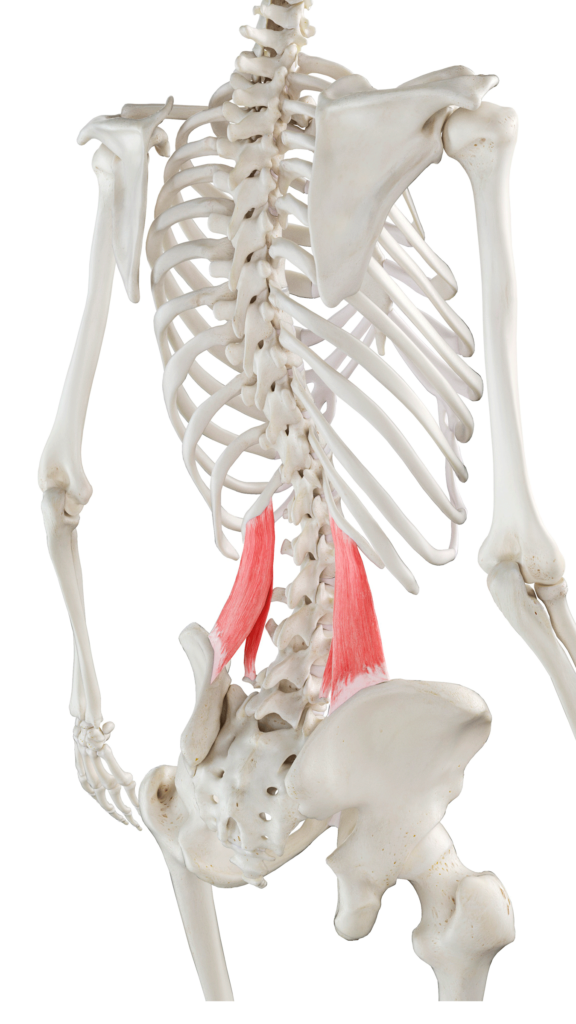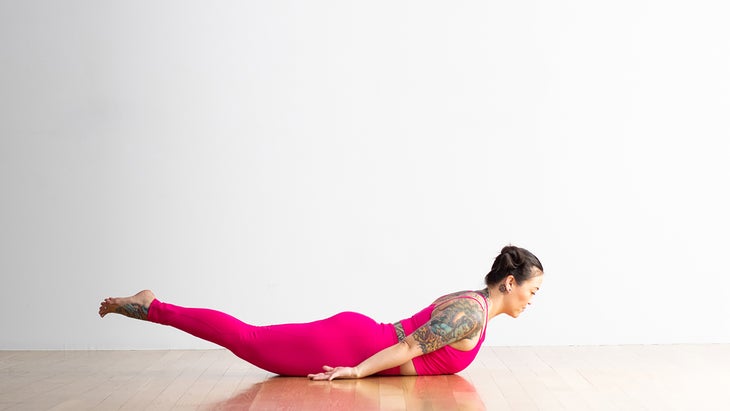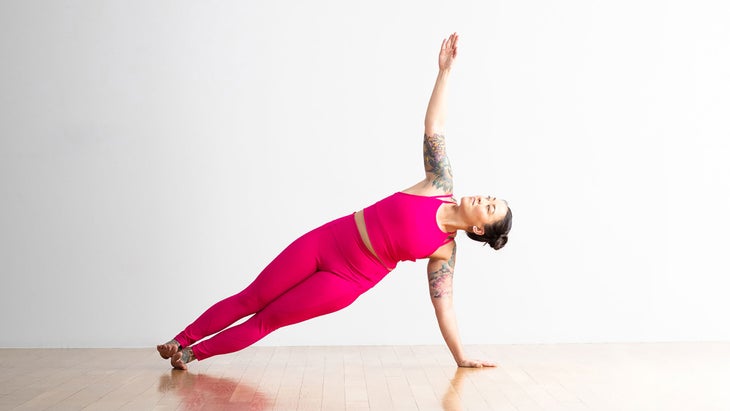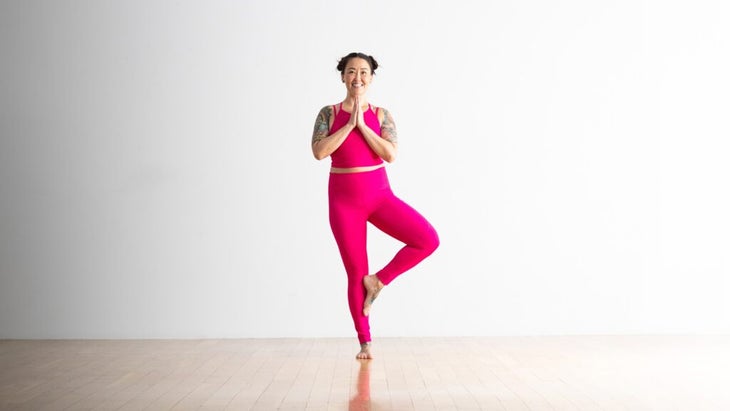Heading out the door? Read this article on the new Outside+ app available now on iOS devices for members! Download the app.
If you practice yoga, run, hike, ski, cycle, surf, swim, or just want to feel more stable as you go about your everyday life, you need to be aware of an easily overlooked pair of muscles that plays a critical role when it comes to core strength and stability: The quadratus lumborum, often referred to as the QL.
Because they’re buried deep within the body, the QL muscles tend to be silent supporting players. Strong and flexible quadratus lumborum muscles can help you find ease in your movement, while weak or tight QL muscles can be the culprit behind nagging low back pain. So how, exactly, do you know whether you need a quadratus lumborum stretch or a strengthening exercise, especially when you may not have even known these muscles existed?
What Is the Quadratus Lumborum?
You have two quadratus lumborum muscles, one running along either side of your lumbar spine. Each connects the lowest rib and the lower five vertebrae to the iliac crest of the hip bone.The QL is essentially a continuation of the transversus abdominis, another of your innermost core muscles.

Although they’re rarely mentioned, the quadratus lumborum muscles are essential in several everyday actions, including side bending, backbending, and stabilizing the spine in almost any position.
They’re also integral to the simple act of breathing. By stabilizing the lower rib, the QL helps the chest cavity expand and allow you to draw as much air into your lungs as possible.
Each time you engage in vigorous physical activity—whether endurance activities or intense yard work—you engage the QL muscles. You even use them while carrying a heavy bag of groceries.
What Causes Tightness in the QL?
The primary cause of soreness in the quadratus lumborum is overwork. When your more superficial core muscles lack strength, your posture collapses, and much of the workload necessary to maintain integrity in the lumbar spine (low back), hips, and pelvis falls on the small and typically weak QL muscles. Because these muscles work overtime to compensate for core weakness, they can easily become tight and sore.
The QL muscles are further taxed by habits such as slouching, leaning on one elbow at your desk, or lying on your side in bed and resting your head on one hand.
How to Know When You Need QL Stretches
One symptom of tightness in the QL is a subtle sensation similar to a deep ache in your low back—whether a soreness, dull throbbing, or vague discomfort. It will tend to linger after prolonged sitting or standing as well as breathing hard or coughing.
QL tightness can also present as difficulty engaging in static activities, such as prolonged sitting or standing, and in dynamic activities of any sort. You might also feel somewhat constricted in certain movements, primarily side bends.
5 Best Quadratus Lumborum Stretches and Strengthening Exercises
The solution to a weak and tight QL is typically to strengthen and stretch the muscles. The following quadratus lumborum stretches can help address stiffness and soreness in these innermost core muscles.

1. Side Bending Poses
Any yoga pose that includes side bending will target tight QL muscles. These postures contract one QL muscle while they stretch the other. The contracted side initiates the bend and strengthens the QL on that side, while the opposite side experiences a quadratus lumborum stretch. Don’t forget to practice the following poses on each side to balance the stretching and strengthening:
Extended Side Angle Pose (Utthita Parsvakonasana)
Extended Triangle Pose (Utthita Trikonasana)
Side Seated Wide Angle Pose (Parsva Upavistha Konasana)
Gate Pose (Parighasana)
Head to Knee Pose (Janu Sirsasana)
Revolved Head to Knee Pose (Parivrtta Janu Sirsasana)

2. Backbending Poses
If you experience tightness or pain in one QL or the other or in both, yoga poses that include a gentle backbend can be helpful strengthening exercises. They contract the quadratus lumborum muscles simultaneously and the two muscles synergistically help you bend backward. Focus your attention along the lower part of your spine and try to initiate movement from there so you’re actually working the QL muscles and not simply lifting yourself away from the floor with your hands and arms. Backbending poses include:
Cat–Cow
Cobra Pose (Bhujangasana)
Locust Pose (Salabhasana)
Upward-Facing Dog Pose (Urdhva Mukha Svanasana)

3. Stabilizing Poses
Since one of the primary functions of the QL muscles is to help stabilize the lower back, particularly in static positions, you can strengthen both quadratus lumborem muscles at once by practicing long holds in poses that require your body to engage the core for stability.
These types of strengthening exercises can help support you when you’re working at a desk for long stretches of time or cycling and needing to keep the body stationary as you generate a powerful pedal stroke. Stabilizing poses beneficial to the QL include:
Extended Mountain Pose (Urdhva Hastasana)
Plank Pose
Four-Limbed Staff Pose (Chaturanga Dandasana)
Side Plank (Vasisthasana)
Boat Pose (Navasana)
Chair Pose (Utkatasana)
Handstand (Adho Mukha Vrksasana)

4. Balancing Poses
Some of the best QL strengthening exercises focus on balancing. Shifting all your weight to one leg at a time helps distribute the workload to each QL muscle rather than stressing both at the same time (which can allow the stronger one to compensate for the other). Balancing poses that isolate and strengthen one QL at a time include:
Tree Pose (Vrksasana)
Warrior 3 Pose (Virabhadrasana III)
Half Moon Pose (Ardha Chandrasana)

5. Hip-Hiking Poses
Additionally, the QL is involved anytime you engage in “hip hiking,” which refers to lifting one leg, whether you’re walking, running, hiking, climbing stairs, practicing yoga, or bringing your foot to the top of the pedal stroke when cycling or on an elliptical machine. Repeating this movement strengthens the QL. Yoga poses that cause one QL to contract and “hike the hip” often include:
Eagle Pose (Garudasana)
Tree Pose (Vrksasana)
Chair With Figure 4 (Utkatasana)
RELATED: 8 Yoga Poses to Strengthen ALL Your Core Muscles
About Our Contributor
Amber Sayer is a fitness, nutrition, and wellness writer and editor. She holds a master’s degree in exercise science and a master’s degree in prosthetics and orthotics. She is a NCSA-certified personal trainer, UESCA-certified running coach, triathlon coach, and endurance nutrition coach.